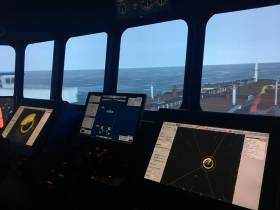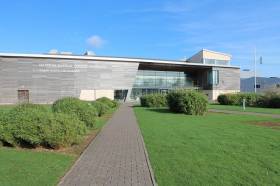Displaying items by tag: NMCI Open Day
Maritime Careers Event & Open Day At NMCI, Cork Harbour
Thinking of a career at sea? as the annual Maritime Careers Event and Open Day will take place next month at the National Maritime College of Ireland (NMCI).
The event at the waterfront college campus in Ringaskiddy, Cork Harbour is to be held on Thursday, 7th November from 10:00 to 15:00.
Representatives from international shipping companies and maritime organisations will be available to provide information about careers in the maritime industry.
Throughout the day there will be:
- Tours of the state of the art training facilities at the college.
- An events’ hall to visit international maritime companies and organisations.
- Presentations for schools and students on course opportunities at the NMCI.
For enquiries and group bookings please telephone NMCI: (021) 4335607
To email: [email protected]
Careers at Sea: National Maritime College of Ireland's (NMCI) Open Day 8th November 2018
#Jobs&Careers - Ireland has a proud maritime tradition and the National Maritime College is offering an opportunity to build on that at its Open Day, the annual event held in the College at Ringaskiddy in lower Cork Harbour.
It will take place on Thursday, 8th November, when the College campus opens its doors to the public who can see the top, international state-of-the-art facilities which it has. They are a powerful statement of the importance of the maritime sector to this island nation and impressive to see.
This is a day when anyone interested in a career at sea can pursue the many options available in a wide, varied and challenging sector which offers huge opportunities.
Representatives from international shipping companies and maritime organisations will be present to meet and discuss available careers, providing information to visitors about jobs throughout the wide sphere of the maritime industry, both at sea and ashore.
There will be presentations for schools and their pupils on marine course opportunities at the NMCI.
The Open Day will run from 10:00 a.m. to 3:00 p.m., with tours of training facilities at the college throughout the day and, in the Events Hall, the opportunity to visit international maritime companies and organisations.
Enquiries and group bookings please telephone: (021) 433 5607. E-mail: [email protected]
In addition to overall information about the college, click here.
A Career at Sea: Open Day at the National Maritime College
#NMCIopenDay - The National Maritime College of Ireland (NMCI) is set to open it’s doors to the public for the annual College Open Day on October 22nd. The college located at Ringaskiddy in lower Cork Harbour will be open between 10:00 and 15:00.
The Open Day is for all from transition year students, to leaving certificate students, teachers and parents. The college will welcome members of the public to have an opportunity to tour the state of the art facilities at NMCI, a $100million dollar facility.
Degree courses are on offer at the NMCI. They are a B.Eng. in Marine Electrotechnology, B.Eng. in Marine Engineering or a B.Sc in Nautical Science. So should they peak your interest you will have an opportunity to find out about each of the courses.
A recent study by Drewry estimates the current officer supply to be 610,000, representing a shortfall of 19,000 personnel. This shortfall is forecast to rise to 21,700 by 2018 given that there will be a requirement for an additional 38,500 officers by this time.
As there is a placement element amongst these courses, NMCI have partnered with key industry leaders to give students seagoing time. A number of our industry partners will also be present on October 22nd to discuss employment opportunities with students.
‘Open Day’ at the National Maritime College of Ireland
#OpenDay@NMCI – An 'Open Day' at the National Maritime College of Ireland (NMCI), Europe's only purpose built maritime education college which celebrated its 10th anniversary earlier this month, is to be held on Tuesday 21 October.
Times for the Open Day are 10am-3pm. Visitors can take tours to view the impressive facilities located at the campus in Ringsakiddy, Cork Harbour.
The world class maritime education and training centre at NMCI became the first third level college in the country to be built under the Government's Public-Private Partnership scheme.
NMCI is a constituent college of CIT and brings together the Irish Naval Service and Merchant Marine under one roof in one of the most advanced maritime academies of its type in the world.
For further information about the Open Day, enquiries and bookings for large groups contact NMCI Tel: (021) 433 5607 by email: [email protected] and for more visit the website: www.nmci.ie
'Open Day' at National Maritime College of Ireland
#NMCIopenday - An 'Open Day' at the National Maritime College of Ireland (NMCI) is to held on Tuesday, 22 October 2013 between 10:00 to 15:00hrs.
Representatives from international shipping companies and maritime organisations will be available to provide information about careers in the maritime industry.
These companies provide employment and sponsorship to students undertaking courses offered by the National Maritime College of Ireland. Throughout the day there will be tours of the state of the art training facilities at the college including the multi-million euro ship simulators, sea survival centre and engineering workshops.
Presentations by the maritime companies of their career opportunities.
An events' hall to visit international maritime companies and organisations.
Presentation for schools and students on course opportunities at the NMCI.
Enquiries and group bookings: Tel: (021) 433 5607. E-mail: [email protected] National Maritime College of Ireland, Ringaskiddy, Co Cork. For more about the NMCI visit: www.nmci.ie
































































